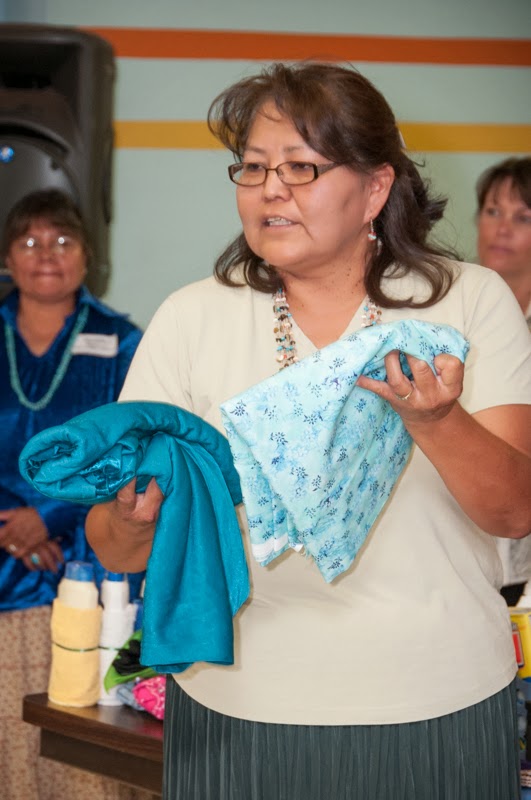by John Aldrich
At the warehouse, the first few months of the year are devoted to preparing the giveaways that Elders will receive on the food runs as well as the gift boxes that sponsors can order. One of the biggest jobs for our warehouse volunteers is the preparation of the fabric that will be used for both giveaways and gift boxes. Two years ago we began to order and cut the fabric ourselves which has saved us considerable money but is labor intensive. This blog, written in 2012, describes the process that we devised to accomplish the task.
We are now in the midst of working on the fabric for the 2014 food runs, and the warehouse once again looks like the back room at Hancock's (except at Hancock's you probably wouldn't find guys doing this work).
Please refer back to the link above to see in greater detail how the cutting process works at our "shop".
We make an effort at the warehouse to make each giveaway something special for the Elder who will receive it. In the case of the fabric, this involves rolling it and tying it up with a ribbon. Robin Field-Williams is one of the volunteers working on this final touch.
This is the second week of our textile operation, so quite a bit of inventory has already been accumulated. It takes 12 to 15 volunteers to keep this assembly line running and 6 volunteer days or 3 weeks to finish the fabric project.
Here is some of the green panne fabric that will either end up as giveaways at the food runs or be put into Grandma boxes that can be ordered by sponsors.
Waiting for their turn at the cutting tables are these bolts of calico.
Here are some interesting facts and figures supplied by C.J. Robb who manages our warehouse operations:
We order a total of 6300 yards of fabric from a wholesaler. This costs around $20,000. Although this is a large sum, it represents a saving of about $9000 over what we paid prior to 2012 to order the fabric locally and have it cut for us.
The fabric order includes 2700 yards of heavy panne which is cut into 3 yard pieces, and 3600 yards of lighter calico which is cut into 4 yard pieces. These bundles will be split between giveaways and Grandma boxes. Grandma boxes contain, among other things, a bundle of panne and a bundle of calico, enough for an Elder to make a whole outfit - skirt and top. We will assemble 400 of these boxes which will be split between the spring and fall food runs.
500 bundles of panne and calico will be split between the spring and fall food runs and used as giveaways. These are among the most popular of the gifts that Elders receive and among the most mentioned when Linda receives thank-you letters.
It's clear that a lot of effort takes place behind the scenes to make these beautiful gifts for the Elders possible. We owe a huge amount of thanks to our warehouse volunteers, the unsung heroes of ANE.
What happens when all this material gets to the reservation?
Here is Mary Begay explaining to the Grandmas at Navajo Mountain that each will receive a Grandma box as a gift provided by a grant from American Express and that each box will contain a bundle of panne and one of calico.
Rena Greyeyes holds the contents of her Grandma box including the fabric.
Here Linda helps an Elder at Leupp pick out a color.
And at Navajo Mountain, an Elder considers the choices among the bundles of calico.
The final outcome of all this effort from warehouse-to-foodrun-to-hogan is a completed outfit that might be worn at the next food run. Bessie Paul of Dilkon proudly wears hers.
Subscribe to:
Post Comments (Atom)










No comments:
Post a Comment